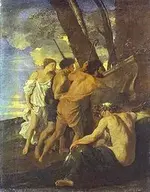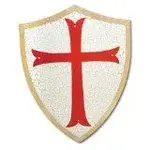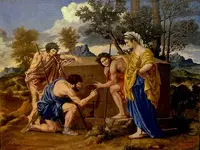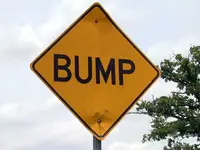Victorio,
He is what we do know:
Copied and pasted from around the web...
"Et in Arcadia" is Nicolas Poussin's elegiac meditation on a Latin phrase found in Virgil's fifth eclogue that translates literally as "Even in Arcady, there am I," or "Death is even in Arcady," but has been interpreted in various ways through the ages. Erwin Panofsky treats the phrase, and Poussin's possible interpretation, in depth in his "Meaning and the Visual Arts." The inscription is discovered on a tomb by a group of shepherds and absorbs them in contemplation of the idea of mortality, a concept they seem to understand with Stoic resignation''
''The term "Arcadian" has gone through many transformations through the ages as well. A native race of the wild hills of the Peloponnesos in southern Greece, the Arcadians were "a tribe older than the moon" certainly pre-dating the Dorian invasions, or "the birth of Jupiter" and the establishment of the Olympian Pantheon. According to Curtis N. Runnels in the March 1995 issue of Scientific American they may have inhabited the area as early as 50,000 years ago causing, through millennia of poor land management, the severe erosion that created the wasteland of dry shrubs and rocks we visit today. The popular term "Arcadian," describes a utopian garden paradise where serene pastoral folk drink, dance and lounge around in an endless summer. It is here in this untroubled land that Nicolas Poussin's shepherds first encounter the solemn reality that all things must pass.

The second version of Poussins'
Arcadian Shepards
This atmosphere of nostalgia in Utopia has survived as the philosopher's definition of "Arcadia," leaving behind a vital and ancient tapestry of folklore. In the reality of mythological Arcadia there were many terrifying dangers, the least of which was death, for its vast population of nymphs, dryads, naiads, satyrs, fauns, Cyclops and lesser gods such as Pan and occasionally Dionysus. Perhaps it was these disenfranchised deities who brought with them the carpet of lush vegetation that transformed the rocky wasteland into the wild and crazy playground of Ovid's "Metamorphoses". In a sense, classical Arcadia was never a Utopia, and its character is as complex and mysterious as the human psyche.
It may indeed be the place where the clear and rational Olympians banished those untamed and unnamable qualities, far from the ordered hierarchies needed by a dynasty of tyrannical sky-gods. Arcadia is then the anarchist state inhabited by uncontrollable misfits where Pan keeps vigil over his domain, scaring away rational beings with his unearthly howls and screeches. Maybe Poussin's painting has more of a lesson than even he realized. Death is not in Arcadia, because the wasteland of Arcadia, like the subconscious, like the moon, like cyberspace, is the realm of the imagination, where all things are possible.
More from Poussin's egmatic sentence..pure code it is beleived
While the phrase "et in arcadia ego" is a nominal phrase with no finite verb, it is a well-formed construction because substantive and copular verb omission is perfectly acceptable in Latin.
Pseudohistorians unaware of that aspect of Latin grammar have concluded that the sentence is incomplete, missing a verb, and have speculated that it represents some esoteric message concealed in a (possibly anagrammatic) code.
In The Holy Blood and the Holy Grail, Baigent, Leigh, and Lincoln, under the false impression that "et in arcadia ego" was not a proper Latin sentence, proposed that it is an anagram for I! Tego arcana dei, which translates to "Begone! I keep God's secrets", suggesting that the tomb contains the remains of Jesus or another important Biblical figure.
They claimed that Poussin was privy to this secret and that he depicted an actual location. The authors did not explain why the tomb depicted in the second version of the painting should contain this secret while the distinctly different one in the first version presumably does not. Ultimately, this view is dismissed by art historians.
In their book The Tomb of God, Richard Andrews and Paul Schellenberger, developing these ideas, have theorized that the Latin sentence misses the word "sum". They argue that the extrapolated phrase et in arcadia ego sum could be an anagram for
arcam dei tango iesu, which would mean "I
touch the tomb of God — Jesus". Their argument postulates that:
the Latin phrase is incomplete.''
( It is further thought that this could be translanted to "I hold the secrets of Jesus' ie the Holy Grail and even Ark of the Convenant, and the Knight Templar being the Guardians of these Holy Relics! Even to the point the Oak Island mystery COULD have been done by the KT and the treasure could be these relics..)
the extrapolation as to the missing words is correct
the sentence, once completed, is intended to be an anagram
~~~end copy~~~
Seems the thread continues with the idea that the 'immigrants' to Nova Scotia (New Scotland) and the Sinclairs
descendants of the Knights Templar, where called 'Arcadians'!
Clan Sinclair Society of Nova Scotia
This group is active in celebrating the 600th anniversary of Prince Henry Sinclair's visit to North American in 1398. For example, it has built an interpretative memorial to Prince Henry's Atlantic Voyage in 1398 overlooking Guysborough Harbour in Nova Scotia, thought to be Prince Henry's landfall site in Nova Scotia.
Dawn (Sinclair) Hemeon, Vice President, Clan Sinclair Society of Nova Scotia, remarks, ``We have a series of events to celebrate the 600th anniversary of this historic occasion
"Arcadia" is a little more difficult to pin down because it is almost philosophical in concept. Arcadia is not a real place; rather it is a place that represents to us that mythological land where there was no strife or conflict either on personal or national levels; people lived in harmony with their enviroment, pursued poetry, music,love; lived in freedom and peace with neighbours without war and you get the idea. It actually is relevant to Sinclairs because as Baigeant et al. pointed out in Holy Blood and the Holy Grail, The Prieure de Sion, that murky semi-secret group that is supposed to have an unbroken chain of grand- masters all the way back to the Merovingians and the descendants of Christ and Mary Magdalene, numbered Poussin the French artist of the Baroque period as one of their grand-masters and he was into "Arcadia" in a big way. The French St. Clairs are regarded as semi-regal by Baigeant and were the guardians of the secret of the Holy Blood and for whom "Arcadia" represented the lost secrets if not also lost innocence
So Victorio, you see the truth always takes things to the next level, while half truths and distortions always
send the energy to ground, where it dies.
hope this helps
rangler









![BUMP[2].webp](/data/attachments/336/336449-a83bbe01b8d16a2075f9da29e8f6fbeb.jpg?hash=dnDBnAIvFk)

